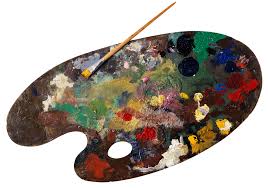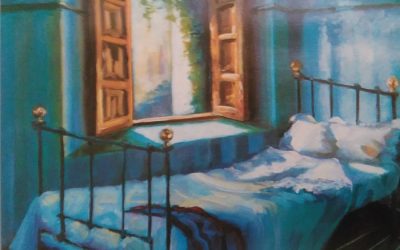In order to use paper for art projects you first need to know more about paper and its characteristics so you would be able to choose the right kind of paper for your specific art project.
Basic Characteristics Of Paper
Paper is made of a paste containing linen and cotton fibres, cellulose, and binder. This thick paste is pressed by the rollers which determine the outer texture of the paper its dimensions and the quality. The quality of the paper depends on the material used for the paste. The paper used for art projects has to have certain characteristics and that are :
1. Resistance to light-Different types of paper reacts differently under the influence of light. Paper made of linen or cotton is more resistant to light then the paper made out of wood, which loses its colour in time and turns yellow or grey. To determine papers resistance to light we can do a simple test, just put a piece of paper partially in the book and leave it exposed to sunlight for 15 days and if you see a significant difference in colour after that period of time it means that the paper will change in ordinary light as well meaning the tone of the painting made on that paper will also change.
2. A good paper has to have a certain outer texture. For watercolour paints, we need a grainy surface(rough) which is not suitable for calcimine paints.
3. A good paper is elastic, bent on the edges goes to its former shape very quickly.
4. The whiteness of the paper is one of the necessary qualities in watercolour painting. The whiteness gives the colour a “fresh” look.
Preparing The Paper For Art Projects
All surfaces no matter of the origin are hygroscopic which makes them expand and contract due to moisture. This is the biggest challenge which painters have to face in order to make their work more durable. There are many ways to limit the hygroscopicity of surfaces, as are a good choice of surface and ground.
A painting is usually made of three layers: surface, ground, and colour. Each layer reacts differently to the external influence because all have a different chemical structure, meaning each layer contracts and expands differently. Movement of all three layers of the painting is uneven which can cause the cracks to appear on the paint and damage the painting. To avoid that we need to prepare the surface differently depending on the type of the colour we are going to use for our painting.
If we are using the paper for sketches than it is not necessary to prepare it in any way, but if we are using it for oil colours, watercolours or calcimine paints we need to strengthen the paper by applying it on another surface. We usually apply paper on to the cardboard, board, plywood board etc. To apply paper on a surface we use glue made of starch, take 50 gr of starch mix it with a bit of cold water then add it to 250gr of hot water and stir until the mixture is cold. Make sure your mixture has no lumps left.
Applying Paper On Surface
Apply glue on one side of the paper, apply a thin layer on one side of surface too, place the paper on the surface and rub gently with clean white cloth from the middle to the sides. Make sure you do it so that there are no air bubbles left between the paper and the surface, put something on top of the paper to apply pressure on it and leave it to dry. If you didn’t rub it properly and there are some air bubbles left you just cut them with a razor blade and apply a thin layer of the glue, and again apply some pressure on the paper.
Applying Paper On A Frame
Moist one side of the paper and wait for it to dry a bit and apply glue on the outer side of the frame. Put the paper on the frame and stretch it carefully. Make sure not to make the outer side of the paper dirty. Leave the paper to dry placed horizontally away from the draft on room temperature. Now your paper is ready for priming.
Priming
If the paper is of good quality, meaning heavy enough, white and resistant to light there is no need for priming if it’s used for watercolour or calcimine paints. For painting with oil colours paper always needs to be primed, but in a manner to keep intact the whiteness of the paper and its outer structure. Priming reduces the surface absorption, unprimed surfaces absorb colour very much which makes them turn grey in time.
Painting on an unprimed surface is very slow. First layers change colour and become the ground for the next layers, meaning you have to use much more time and colour which doesn’t come cheap. The ground gives the surface the whiteness. Each colour looks brighter and nicer on the white surface. It is always better to apply ground yourself because you really never know much about the quality of priming of the purchased already primmed painting surfaces. Even if you by already prepared painting surface my advice is to apply at least one layer of gesso on it.
In order to use oil colour for painting on paper, you should apply ground on paper glued to a board or a frame. For oil colour, you can just use acrylic gesso primer which you apply to paper in a very thin layer using a large soft brush, if necessary ad some water to the primer so that is the consistency of heavy cream. After the first layer is dry apply another layer of gesso in the opposite direction of the first one.
For pastel, you use paper added to a board or plywood board which helps your painting be more stable and durable. Add a very thin layer of starch glue to the paper, while it is still wet cover it with bimsstein powder making sure it is covering the whole surface of the paper evenly. After it is dried place the surface at an angle and remove unnecessary powder by tapping the surface from the back side. The surface prepared in this manner is ready for pastel painting and can also be used for carbon drawings.
Again I want to say that if all this sounds complicated to you can always by already prepared surface for a specific type of artist material you intend to use but it will never be the same quality and durability as the surface you prepare yourself.
If you have any questions regarding the subject feel free to leave them below and I shall be happy to help.





0 Comments